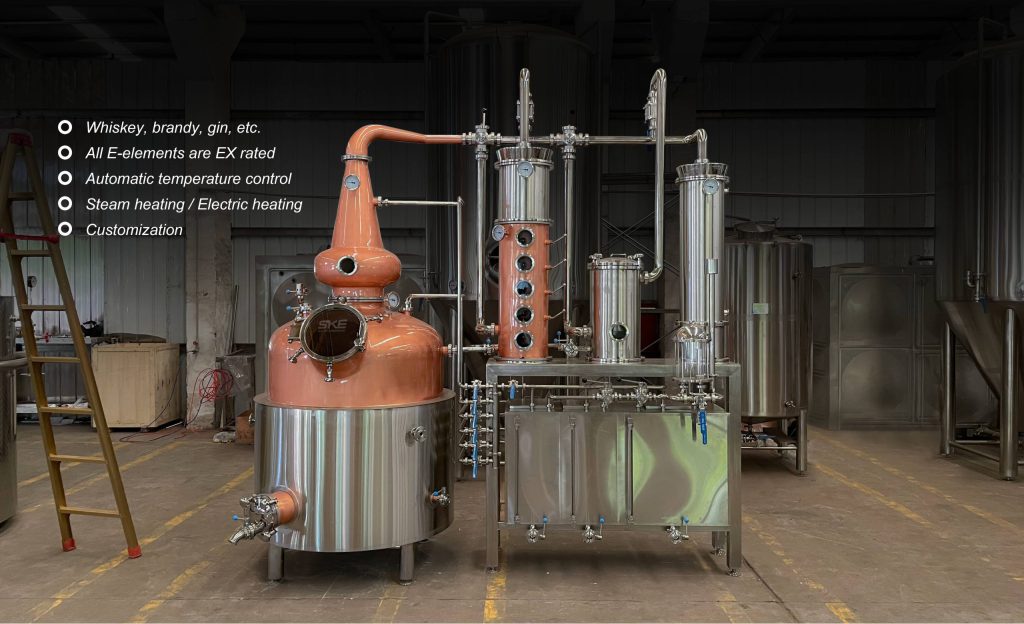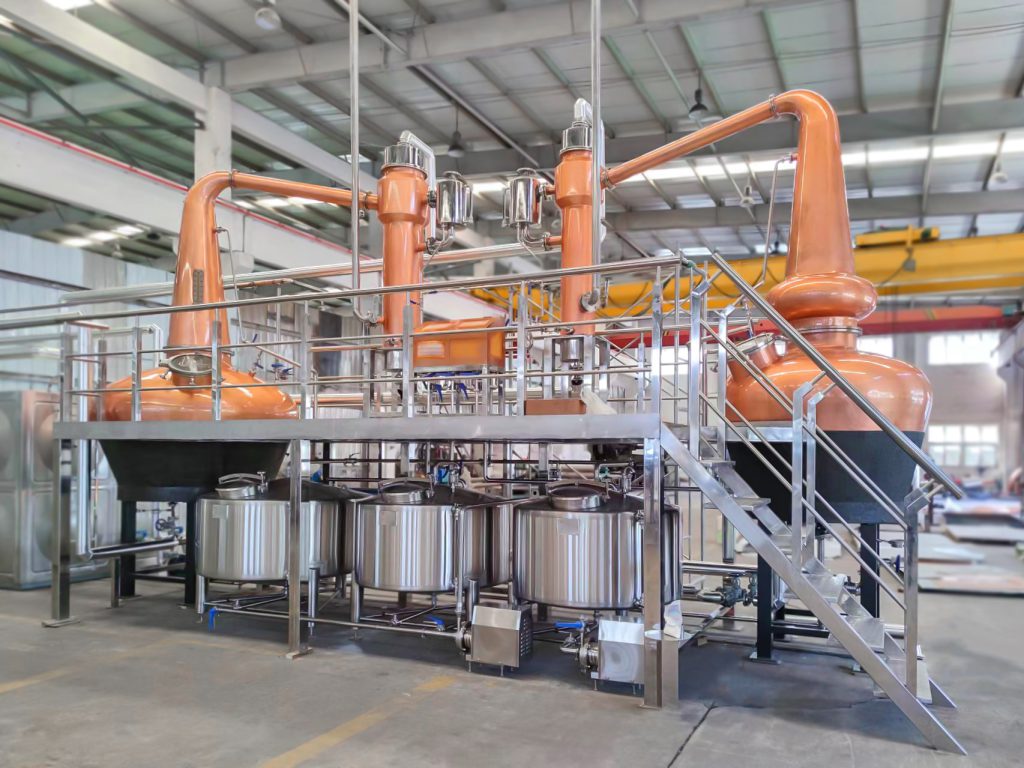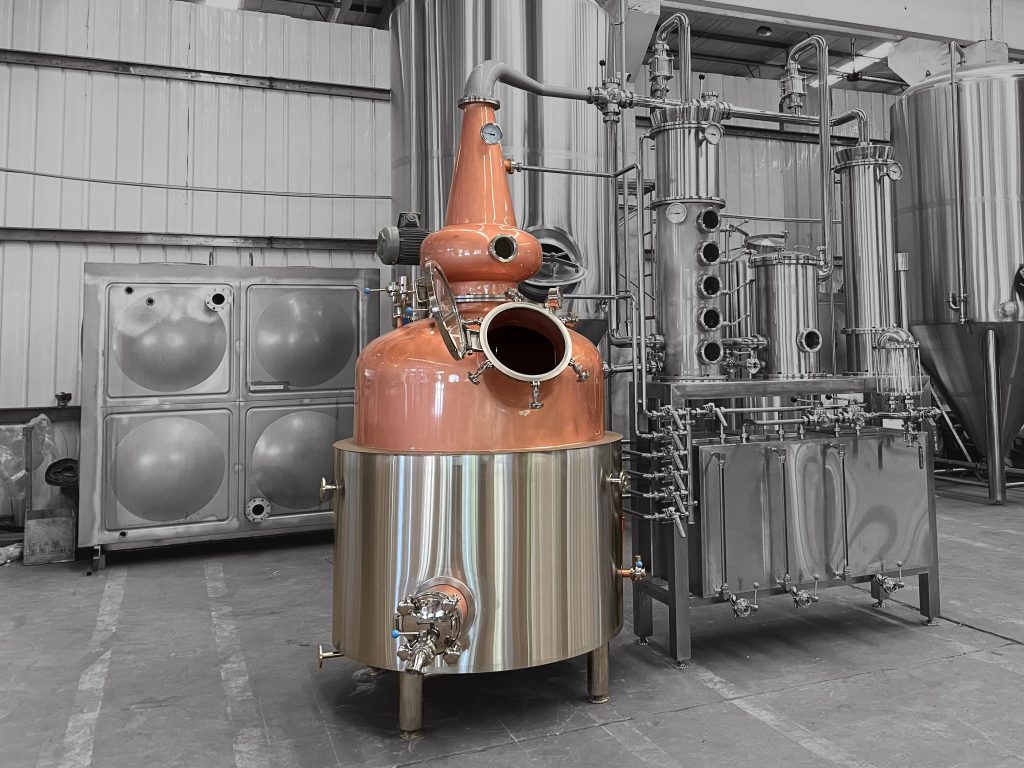Introduction
Choosing the right single pot still for your distillery is a critical decision that can significantly impact the quality of your spirits. A single pot still, also known as a pot still, is a type of distillation apparatus traditionally used for the production of whiskey and other spirits. This guide will help you navigate through the essential factors to consider when selecting a single pot still, ensuring you make an informed choice that aligns with your distillery’s goals.
Understanding Single Pot Stills

What is a Single Pot Still?
A single pot still is a type of still used for distilling spirits that operates on a batch process. It consists of a pot, a swan neck, and a condenser. The pot is where the wash (fermented liquid) is heated, and the swan neck directs the vapor to the condenser, where it cools and returns to liquid form. Single pot stills are renowned for producing rich, full-bodied spirits with complex flavors.
Types of Single Pot Stills
Single pot stills come in various designs and sizes. The main types include:
Copper Pot Stills: Known for excellent heat conductivity and removing sulfur compounds, enhancing the spirit’s flavor.
Stainless Steel Pot Stills: Durable and easier to maintain but less effective in removing impurities compared to copper.
Hybrid Pot Stills: Combine elements of both pot stills and column stills, offering versatility in production.
| Type of Still | Material | Advantages | Disadvantages |
|---|---|---|---|
| Copper Pot Still | Copper | Excellent heat conductivity, removes sulfur | Requires more maintenance, higher cost |
| Stainless Steel Still | Stainless Steel | Durable, low maintenance | Less effective in removing impurities |
| Hybrid Pot Still | Copper and Stainless Steel | Versatile, combines benefits of both | More complex design, higher initial cost |
Key Factors to Consider
When choosing a single pot still for your distillery, several key factors must be considered to ensure you select the best equipment for your production needs. Each factor plays a significant role in the efficiency, quality, and overall success of your distillation process.
Material
The material of the single pot still is one of the most critical factors. The choice between copper and stainless steel can influence the flavor, quality, and maintenance of your spirits.
- Copper: Copper is traditionally the material of choice for pot stills. It has excellent thermal conductivity, which allows for even heating of the wash. Copper also reacts with sulfur compounds produced during fermentation, removing these undesirable elements and resulting in a smoother, cleaner spirit. However, copper stills require more maintenance due to the metal’s tendency to oxidize and wear over time.
- Stainless Steel: Stainless steel is more durable and easier to maintain than copper. It doesn’t react with sulfur compounds as copper does, which means it might not remove as many impurities from the spirit. However, stainless steel stills are often lined with copper in critical areas to combine the durability of stainless steel with the beneficial properties of copper.
Size and Capacity
The size and capacity of the single pot still are essential considerations, as they directly impact your production volume and flexibility.
- Small-Scale Stills: Ideal for craft distilleries and experimental batches, smaller stills allow for greater control over the distillation process and the ability to produce limited-edition or specialty spirits.
- Large-Scale Stills: Necessary for commercial production, larger stills enable higher output and can meet the demands of a larger market. However, they require a more significant initial investment and more space within the distillery.
- Scalability: Consider your future growth when choosing the size of your still. Investing in a still that can handle increased capacity as your distillery expands can save time and money in the long run.
Design and Shape
The design and shape of the single pot still significantly influence the characteristics of the distilled spirits. Key design elements include the pot, neck, and condenser.
- Pot Shape: The shape of the pot affects the surface area and the rate of evaporation. A wider pot allows for more surface contact and a quicker evaporation process, which can lead to different flavor profiles.
- Neck Height and Shape: The height and shape of the neck (swan neck) affect the reflux process. A taller neck increases reflux, which means the vapor condenses and falls back into the pot more frequently before exiting the still. This results in a purer distillate with fewer impurities.
- Lyne Arm Angle: The angle of the lyne arm (the tube connecting the neck to the condenser) influences how much reflux occurs. An upward angle increases reflux, while a downward angle allows more flavor compounds to pass through, creating a heavier spirit.
- Condenser Type: The type of condenser (worm tub or shell and tube) affects the cooling rate of the vapor. Worm tubs are traditional and can add distinct characteristics to the spirit, while shell and tube condensers are more efficient and easier to clean.
Heat Source
The heat source used to operate the single pot still is another crucial consideration, affecting both the distillation process and the flavor profile of the spirits.
- Direct Fire: This traditional method involves heating the pot directly with an open flame. It provides intense, localized heat, which can lead to caramelization of the wash at the bottom of the pot, adding unique flavors to the spirit. However, it can also cause scorching if not carefully monitored.
- Steam Heating: Steam jackets or coils provide a more controlled and even heating method. This reduces the risk of scorching and allows for precise temperature control, which is crucial for producing consistent, high-quality spirits. However, it requires additional equipment, such as a boiler, which increases initial setup costs.
- Electric Heating: Electric heating elements offer convenience and control, making them popular for smaller distilleries and home distillers. They provide even heat distribution and are easy to operate. However, they may not be suitable for large-scale operations due to limitations in power output.
Customization Options
Customizing your single pot still can enhance its functionality and align it more closely with your distillery’s unique production goals. Consider the following customization options:
- Shape and Design: Custom shapes and designs can influence the reflux and flavor profile of your spirits. Work with manufacturers to create a still that meets your specific requirements.
- Material Upgrades: Adding copper linings to stainless steel stills or incorporating additional copper plates can improve impurity removal and enhance the quality of your spirits.
- Branded Elements: Personalize your still with branded elements such as logos, which can add a professional and unique touch to your distillery equipment.
Maintenance and Care
Regular maintenance and care of your single pot still are essential to ensure its longevity and the consistent quality of your spirits.
- Regular Cleaning: After each distillation run, thoroughly clean the still to remove residues and prevent buildup that can affect flavor and hygiene. Use appropriate cleaning solutions and tools recommended by the manufacturer.
- Inspections and Repairs: Conduct regular inspections to identify potential issues such as leaks, cracks, and signs of wear and tear. Addressing these issues promptly can prevent more significant problems and ensure the still operates efficiently.
- Preventative Maintenance: Implement a preventative maintenance schedule that includes routine checks, part replacements, and professional servicing as needed. This proactive approach can extend the lifespan of your still and maintain optimal performance.
Customization Options

Adding Personal Touches
Many manufacturers offer customization options for single pot stills, allowing you to tailor the still to your specific requirements. Custom features can include unique shapes, specialized condensers, and personalized branding elements. Customization can enhance the efficiency and aesthetic appeal of your distillery setup.
Upgrading Components
Upgrading components such as condensers, copper plates, and additional columns can improve the versatility and performance of your single pot still. These upgrades can help you achieve different flavor profiles and increase production efficiency.
Maintenance and Care
Regular Cleaning
Maintaining your single pot still is crucial for ensuring its longevity and the quality of your spirits. Regular cleaning, especially after each distillation run, helps prevent the buildup of residues that can affect flavor and hygiene.
Inspections and Repairs
Regular inspections can identify potential issues before they become major problems. Check for leaks, cracks, and signs of wear and tear. Prompt repairs can prevent downtime and ensure consistent production.
Conclusion
Selecting the best single pot still for your distillery involves careful consideration of various factors, including material, size, design, heat source, and customization options. By understanding these elements and prioritizing regular maintenance, you can ensure that your single pot still produces high-quality spirits that meet your distillery’s standards.
FAQ
What is the primary advantage of using a single pot still?
The primary advantage of using a single pot still is the ability to produce spirits with rich, complex flavors. The batch distillation process allows for greater control over the final product, resulting in unique and high-quality spirits.
How often should I clean my single pot still?
It is recommended to clean your single pot still after each distillation run. Regular cleaning prevents residue buildup, which can affect the flavor and quality of your spirits.
Can I customize my single pot still?
Yes, many manufacturers offer customization options for single pot stills. You can tailor the design, components, and features to meet your specific production needs and aesthetic preferences.
What type of heat source is best for a single pot still?
The best heat source depends on your specific requirements. Direct fire provides intense heat, steam offers gentle and even heating, and electric heating is convenient and controllable. Each method has its advantages and should be chosen based on your distillation process and setup.
How do I choose the right size single pot still for my distillery?
Choosing the right size depends on your production goals. Smaller stills are suitable for craft distilleries or experimental batches, while larger stills are necessary for commercial production. Consider your current and future production needs when selecting the capacity.

